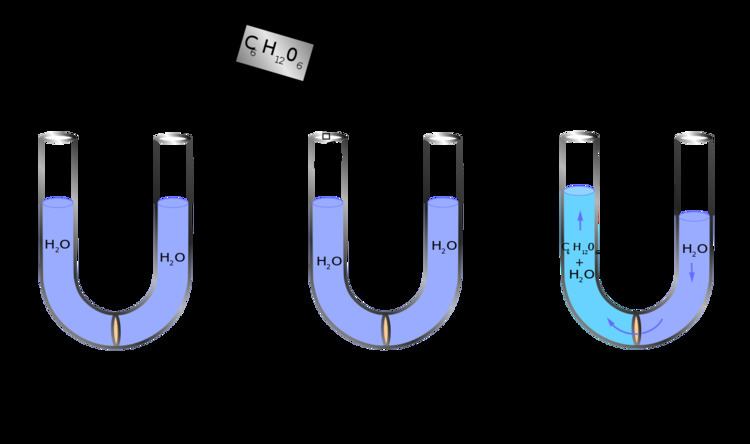 | ||
Osmotic pressure is the minimum pressure which needs to be applied to a solution to prevent the inward flow of water across a semipermeable membrane. It is also defined as the measure of the tendency of a solution to take in water by osmosis. Potential osmotic pressure is the maximum osmotic pressure that could develop in a solution if it were separated from distilled water by a selectively permeable membrane. The phenomenon of osmosis arises from the propensity of a pure solvent to move through a semi-permeable membrane and into a solution containing a solute to which the membrane is impermeable. This process is of vital importance in biology as the cell's membrane is semipermeable.
Contents
Background
In order to visualize this effect, imagine a U-shaped tube with equal amounts of water on each side, separated by a water-permeable membrane made from dialysis tubing at its base that is impermeable to sugar molecules. Sugar has been added to the water on one side. The height of the liquid column on that side will then rise (and that on the other side will drop) proportional to the pressure of the two solutions due to movement of the pure water from the compartment without sugar into the compartment containing the sugar water. This process will stop once the pressures of the water and sugar water on both sides of the membrane become equal.
Jacobus van 't Hoff first proposed a "law" relating osmotic pressure to solute concentration
where
van 't Hoff was the first recipient of the Nobel prize for chemistry for his work on osmotic pressure and chemical equilibrium. [1]
A simple extension of this equation was proposed by Harmon Northrop Morse
where i is a dimensionless correction factor. This formula extends the range of applicability to slightly more concentrated solutions.
Historically, van 't Hoff's law and osmotic pressure measurement have been used for the determination molecular weights. The Pfeffer cell was developed for the measurement of osmotic pressure in biology..
Applications
Osmotic pressure is an important factor affecting cells. Osmoregulation is the homeostasis mechanism of an organism to reach balance in osmotic pressure.
When a biological cell is in a hypotonic environment, the cell interior accumulates water, water flows across the cell membrane into the cell, causing it to expand. In plant cells, the cell wall restricts the expansion, resulting in pressure on the cell wall from within called turgor pressure. Turgor pressure allows herbaceous plants to stand upright. It is also the determining factor for how plants regulate the aperture of their stomata. In animal cells excessive osmotic pressure can result in cytolysis.
Osmotic pressure is the basis of filtering ("reverse osmosis"), a process commonly used in water purification. The water to be purified is placed in a chamber and put under an amount of pressure greater than the osmotic pressure exerted by the water and the solutes dissolved in it. Part of the chamber opens to a differentially permeable membrane that lets water molecules through, but not the solute particles. The osmotic pressure of ocean water is about 27 atm. Reverse osmosis desalinates fresh water from ocean salt water.
Derivation of the van 't Hoff formula
Consider the system at the point it has reached equilibrium. The condition for this is that the chemical potential of the solvent (since only it is free to flow toward equilibrium) on both sides of the membrane is equal. The compartment containing the pure solvent has a chemical potential of
Here, the difference in pressure of the two compartments
In order to find
We can write the left hand side as:
where
where
If the liquid is incompressible the molar volume is constant,
The activity coefficient is a function of concentration and temperature, but in the case of dilute mixtures, it is often very close to 1.0, so
For aqueous solutions of salts, ionisation must be taken into account. For example 1 mole of NaCl ionises to 2 moles of ions.
Non-ideal solutions
A general extension of the van 't Hoff equation uses a virial expansion. For an ideal gas this has the form
were B, C ... are virial coefficients. A similar expression applies to osmotic pressure with
